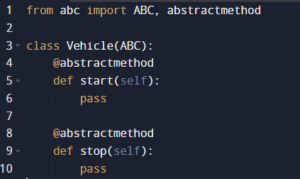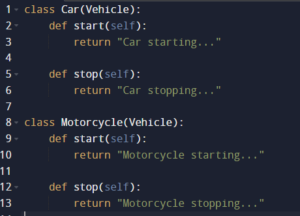In the realm of Python programming, creating well-structured and maintainable code is essential for developing robust applications. Abstract classes are a powerful tool in achieving this goal, providing a framework for defining common interfaces and behaviors across multiple related classes. This approach ensures consistency and promotes best practices in code design. With numerous aspects to consider when implementing abstract classes in Python, mastering this concept can significantly enhance your development skills. This article aims to guide you through the intricacies of abstract classes in Python, shedding light on their purpose, how to define and implement them using the ABC module, and best practices for their use.
Introduction to Abstract Classes
Abstract classes in Python are a fundamental concept that helps developers create a structured and consistent codebase. They provide a blueprint for other classes, defining common interfaces and behaviors while deferring the implementation to the derived classes. This approach ensures that related classes follow a consistent structure, promoting cleaner and more maintainable code.
Definition and Purpose:
- Abstract classes are classes that cannot be instantiated on their own and are meant to be subclassed.
- They define a common interface for a group of related classes.
Defining Abstract Classes with ABC Module
In Python, abstract classes are defined using the ABC module (Abstract Base Classes) from the abc package. This module provides the necessary tools to declare abstract methods and enforce their implementation in derived classes. Here’s how abstract classes are defined and utilized with the ABC module:
- Step 1: Importing the ABC Module:
Begin by importing the ABC class and the abstractmethod decorator from the abc package.
![]()
- Step 2: Declaring an Abstract Class:
To define an abstract class, inherit from ABC.
Use the @abstractmethod decorator to denote abstract methods within the class.
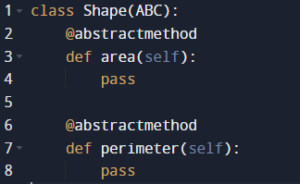
- Step 3: Usage of Abstract Methods:
Abstract methods are methods declared without an implementation (pass statement).
Subclasses of an abstract class must implement all abstract methods defined in the parent class.
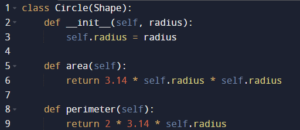
- Step 4: Enforcing Interface Consistency:
Abstract classes enforce a consistent interface across multiple related classes.
They ensure that all subclasses have specific methods defined, promoting code clarity and structur
Benefits of Using Abstract Classes
Abstract classes offer several advantages that contribute to better code design and maintainability in Python:
- Enforcement of Structure:
Abstract classes define a structure that subclasses must follow, ensuring uniformity in method definitions across different implementations.
- Promotion of Code Reusability:
By defining common methods in an abstract class, developers can reuse code across multiple subclasses, reducing redundancy and improving efficiency.
- Enhanced Maintainability:
Abstract classes make code easier to maintain by centralizing method definitions and promoting a modular approach to development.
- Polymorphism and Flexibility:
Abstract classes support polymorphism, allowing different subclasses to be treated interchangeably based on their common interface.
- Clearer Design Intent:
Using abstract classes clarifies the intent of the code, making it easier for other developers to understand and extend.
Implementing Abstract Methods
Implementing abstract methods in Python involves defining methods without implementations in abstract classes and requiring subclasses to provide specific implementations. This approach ensures consistent behavior across related classes while allowing flexibility in individual implementations. Here’s how you can effectively implement abstract methods.
- Use the ABC class and abstractmethod decorator from the abc module to create an abstract base class.

- Subclasses of the abstract base class must provide concrete implementations for all abstract methods defined in the parent class to be instantiated.

Concrete vs Abstract Methods
In object-oriented programming, understanding the distinction between concrete and abstract methods is essential for designing cohesive and maintainable class hierarchies. Here’s an exploration of concrete and abstract methods, highlighting their differences and applications:
- Concrete Methods:
Definition: Concrete methods have a complete implementation in the class where they are defined.

Usage: Concrete methods provide specific behavior that is directly executable and does not require further implementation by subclasses.
- Abstract Methods:
Definition: Abstract methods are declared in abstract classes using the @abstractmethod decorator, but they do not contain an implementation.
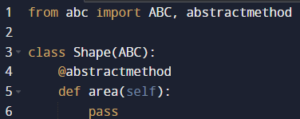
Usage: Abstract methods define a method signature that must be implemented by subclasses, ensuring consistency in behavior across different implementations.
Key Differences:
- Implementation: Concrete methods have a defined implementation in the class, while abstract methods lack implementation and serve as placeholders for functionality.
- Inheritance Requirement: Subclasses of classes containing abstract methods must provide concrete implementations for all abstract methods to be instantiated.
Practical Application:
- Concrete Methods: Useful when methods have a consistent implementation across all instances of a class.
- Abstract Methods: Beneficial when defining a common interface that multiple related classes must adhere to, allowing for polymorphic behavior and ensuring method consistency across subclasses.
Pythonic Implementation:
- Use the ABC module and abstractmethod decorator from the abc package to define abstract methods in Python.
- Implement concrete methods directly within class definitions to provide specific functionality.
Practical Examples of Abstract Classes
Abstract classes in Python provide a powerful mechanism for defining common interfaces and behaviors that subclasses must implement. Here are practical examples illustrating the use of abstract classes in various scenarios:
- Shape Hierarchy:
Abstract Base Class: Define an abstract class Shape with abstract methods area() and perimeter() to calculate the area and perimeter of different geometric shapes.

Concrete Subclasses: Implement specific shapes like Circle and Rectangle that inherit from Shape and provide their implementations of area() and perimeter().
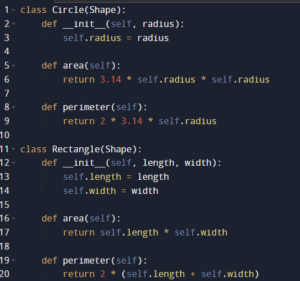
- Database Abstraction:
Abstract Base Class: Create an abstract class DatabaseConnection with abstract methods connect() and disconnect() to manage database connections.

Concrete Subclasses: Implement database-specific connection logic in subclasses like MySQLConnection or PostgreSQLConnection that inherit from DatabaseConnection and provide implementations for connect() and disconnect().
Using Abstract Classes in Real-World Scenarios
Abstract classes are instrumental in designing systems where multiple classes share common behaviors but require specific implementations. Here are real-world scenarios showcasing the utility of abstract classes:
- GUI Frameworks:
Abstract classes define interfaces for components like buttons, menus, and windows, ensuring consistency in interaction methods while allowing customization in appearance and behavior.
- Plugin Architecture:
Abstract classes define interfaces for plugins, specifying methods for initialization, execution, and cleanup, while individual plugins provide their implementations tailored to specific functionalities.
- Game Development:
Abstract classes define interfaces for game entities like characters, enemies, or weapons, ensuring each entity adheres to a consistent set of methods (e.g., move(), attack(), defend()).
- Scientific Computing:
Abstract classes define interfaces for mathematical models or algorithms, allowing researchers to create new models that conform to established input-output specifications.
Best Practices and Common Pitfalls
When working with abstract classes in Python, adhering to best practices ensures effective design and implementation. However, there are common pitfalls to be aware of to avoid potential errors. Here’s a guide to best practices and common pitfalls when using abstract classes:
Best Practices
- Clearly Define Interfaces: Abstract classes should clearly define abstract methods that represent a consistent interface expected by subclasses.
- Use the ABC Module: Utilize Python’s ABC module and abstractmethod decorator to explicitly mark abstract methods and classes.
- Promote Code Reuse: Design abstract classes to promote code reuse by providing common methods that subclasses can implement.
- Document Abstract Classes: Document abstract classes thoroughly, including method expectations and usage examples, to guide subclass implementation.
- Ensure Method Consistency: Ensure all subclasses implement all abstract methods defined in the abstract base class to maintain method consistency.
Common Pitfalls
- Incomplete Implementation: Subclasses failing to fully implement all abstract methods can lead to runtime errors when attempting to instantiate the class.
- Overly Complex Hierarchies: Avoid overly complex class hierarchies with deep levels of inheritance, which can complicate maintenance and lead to confusion.
- Misuse of Concrete Methods: Misusing concrete methods within abstract classes may violate the principle of abstraction and hinder subclass customization.
- Insufficient Documentation: Lack of comprehensive documentation for abstract classes can lead to misunderstandings and errors during subclass implementation.
- Ignoring Error Handling: Failing to implement appropriate error handling in abstract classes can propagate errors throughout the application, affecting overall stability.
Error Handling with Abstract Classes
Error handling in abstract classes involves anticipating potential errors during method implementation in subclasses. Here’s how you can effectively handle errors when working with abstract classes:
- Define Expected Exceptions: Document the expected exceptions that subclasses may encounter when implementing abstract methods.
- Use try-except Blocks: Enclose critical sections of abstract method implementations in try-except blocks to catch and handle specific exceptions gracefully.
- Raise NotImplementedError: Raise NotImplementedError within abstract methods if a subclass fails to implement a required method, providing clear feedback during development.
- Validate Input Parameters: Validate input parameters within abstract methods to ensure they meet expected criteria, preemptively catching potential errors.
- Logging and Debugging: Implement logging statements or debug messages within abstract methods to track method execution flow and identify error sources.
FAQ:
What is an abstract class in Python?
In Python, an abstract class serves as a blueprint for other classes and cannot be instantiated itself. It typically contains one or more abstract methods, which are methods declared but not implemented within the abstract class. Abstract classes are designed to define a common interface that subclasses must implement, ensuring consistency in method signatures across related classes.
How do you define an abstract class using the ABC module?
To define an abstract class in Python using the ABC module from the abc package, follow these steps:
- Import the ABC class and abstractmethod decorator from the abc module.
- Inherit from ABC when defining the abstract class.
- Use the @abstractmethod decorator to mark methods that must be implemented by subclasses but have no implementation in the abstract class itself.
What are the benefits of using abstract classes?
The benefits of using abstract classes in Python include:
- Code Reuse: Abstract classes promote code reuse by defining common method signatures that subclasses must implement.
- Structure and Consistency: They enforce a consistent structure across related classes, enhancing code clarity and maintainability.
- Polymorphism: Abstract classes support polymorphism, allowing subclasses to be treated uniformly based on their abstract interface.
- Design Patterns: Abstract classes facilitate the implementation of design patterns such as Factory Method and Template Method, enhancing software design flexibility.

